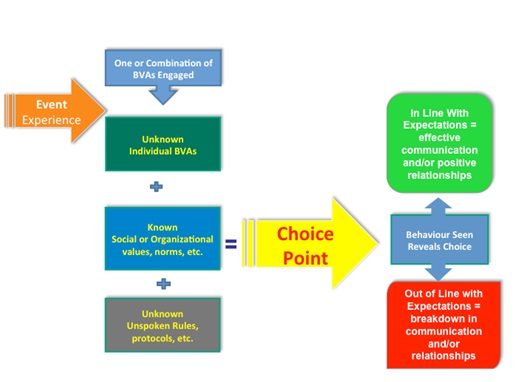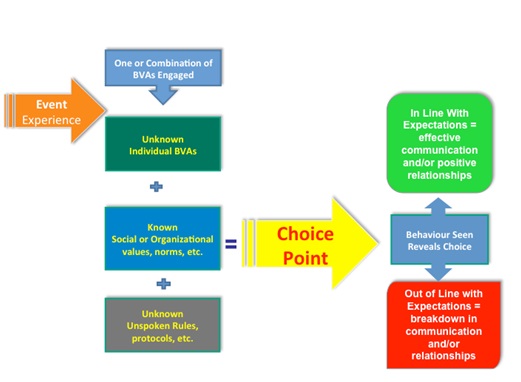A Coaching Power Tool Created by Judy Laws
(Executive Coach, CANADA)
Abstract
This power tool explores the difference between displaying a habitual response versus being response-able. It includes a model, an illustrative example and applications.
Habitual Response Vs. Being Response-able
We all live the experience of cultural conditioning i.e. how we were raised, the environments we have been exposed to, etc. Based on this, we are all predisposed to carry biases. Our beliefs, values and attitudes stem from our individually held belief systems both as they relate to ourselves and as we relate to others in our environment. For example, do we perceive our environment and or the people in it as safe or dangerous and how does that influence our response.
Our BVAs are learned responses and are seeded in our internal reference point for an external event. This becomes, over time, a wired-in response to our environment and by virtue of that a habituated response (the default of us). In some cases habituation serves us well i.e. driving a car, completing daily tasks, etc. however most people don’t realize how their BVA’s impact how they interact with others, how they run default in their lives. Our ingrained belief systems can prevent us from achieving harmony in our life. The graphic below represents the process by which BVAs are expressed in the moment.
Figure 1: BVA’s In Action[1]
 In any event / experience the possibility of all three sets of BVAs can contribute to the choices being made while in it. For example,
In any event / experience the possibility of all three sets of BVAs can contribute to the choices being made while in it. For example,
It is the BVAs that drive behaviour. Not that our BVAs are good, bad, right, or wrong, rather they show up in every interaction we are having, whether in the conversation we are having with ourselves or in the conversations we are having with others.
No matter the BVA or combination of BVAs engaged, each of us has available to us the choice point, that opportunity to make a resourceful[2] choice as it relates to interacting in a conscious and respectful manner. The choice point is where the opportunity lies for interrupting the pattern of habituated behaviour. The choice point is an opportunity to notice ourselves in the interaction. The opportunity to notice the where (environment), what (behaviour) and how (capability) that we are bringing to the interaction hence be response-able versus habitual in our response. When we are response-able our behaviour is typically in line with expectations of others and result in effective communication and/or positive relationships. When our responses are habitual they often are in line with expectations of others and often lead to a breakdown in communications and relationships.
Rather than trying to convince people to change their BVAs, the opportunity is to have them check in with the BVAs that are not serving them or leading to them being un-resourceful in their interactions with others. When we understand why we do what we do, we can no longer help but notice ourselves and our behaviour in the interaction. In noticing ourselves one cannot help but become more response-able in our interactions with each other and accountable for our choices.
Imagine the following situation.
David has been working for his company for 17 years as a software developer. While his manager values the fact that he is a bit of a “disrupter,” he is now having a strong reaction to how David has been interacting with his new team. Specifically, the team has moved to a more collaborative and self-directed team model over the last year, one that requires mutual respect and good listening skills to be able to listen to each other and solve problems together, as well as the courage to be vulnerable and imperfect.
Here lies the problem. David believes it is important to bring to each problem / situation logical and objective thinking i.e. every argument must have strong supporting evidence to ensure that the ‘right’ decision is made.” He will also not let go of a discussion until he has all the information and the answer. This often translates in interactions with his colleagues as “Make me understand!
David has been told that he is too argumentative and too “nit picky.” His team members have been known to walk away frustrated, deflated or annoyed after their interactions with him. Upon reflection, David has recognized that he needs to do a better job at recognizing before people get annoyed with me.
Let’s now let’s look at the BVAs in Action model again in light of David’s example.
 David’s unknown BVA is the need for a right answer. The known BVA is that it is more important to find the right answer and prove that he is right than to have people feel good about the process. The unknown BVA is that others around him with similar approaches i.e. argue with the person until get the right answer is often supported by management. David’s habitual response translates into behaviour that is out of line with expectations of his manager and team of collaboration, mutual respect and good listening skills. Based on the model outlined above, David needs to interrupt his pattern of habitual behaviour of arguing every point to prove he is “right.” There is an opportunity for David to stop and notice his environment, behaviour and the BVAs that he is bringing to his interactions i.e. “choice point” to allow him to be response-able versus habitual in his responses with his team members.
David’s unknown BVA is the need for a right answer. The known BVA is that it is more important to find the right answer and prove that he is right than to have people feel good about the process. The unknown BVA is that others around him with similar approaches i.e. argue with the person until get the right answer is often supported by management. David’s habitual response translates into behaviour that is out of line with expectations of his manager and team of collaboration, mutual respect and good listening skills. Based on the model outlined above, David needs to interrupt his pattern of habitual behaviour of arguing every point to prove he is “right.” There is an opportunity for David to stop and notice his environment, behaviour and the BVAs that he is bringing to his interactions i.e. “choice point” to allow him to be response-able versus habitual in his responses with his team members.
Self-Application
All meaning is context dependent and it is a personal thing. Hence, it is important to note that the behaviour is not about the “thing” however about creating an understanding that the BVAs we carry will influence our response to an event or interaction. This will lead to a greater likelihood of being aware, anticipating past behaviour and choosing a different response in the here and now.
BVAs, whether in or out of our awareness, drive the shape and size of the change / growth in our lives. A question to ask ourselves, as it relates to our lives, our families, our profession, is how are our BVAs impacting our growth and development?
In order to utilize the choice point effectively, we must be consciously aware that in every interaction a choice point exists and then choose to engage it. Engaging the choice point requires mindfully taking a breath. Why? Because it does not take breathing to run the default of us! As long as we have a pulse, we will carry our individually held BVAs. The question becomes how are they serving you in your life and in your relationships.
Coaching Application
In working with a client, a coach can help the client notice himself or herself in the situation they are experiencing, and gain a better understanding of how his or her BVAs could be leading to un-resourceful responses i.e. responses that our out of line with expectations of others and don’t support effective communication and positive relationships.
Possible questions could include:
Reflection
- How are your BVAs serving you as a coach?
- What BVAs are you bringing to the coaching process?
- How do you ensure that you are response-able when you are in a coaching session?
- How do your individual BVAs about an event or interaction impact your interactions with others?
- What old strategies and habits, based on long held and perhaps limiting beliefs do you need to let go of and/or replace?
References:
Kimakowich, K. (now Roberts. K.) Awakening Wave Human Behaviour Education Program Overview, October 2009.
Roberts, K. & Laws, J. Innovation in the Making: Making Your Workplace a Respectful One, presentation delivered as part of Graybridge Malkam’s Breakfast Program, September 2011.
[1] Source: Adapted from the work of Kae Roberts, Awakening Wave Organizational Evolution
[2] Ability to act effectively or imaginatively, especially in difficult situations (retrieved from http://www.thefreedictionary.com/resourcefulness).